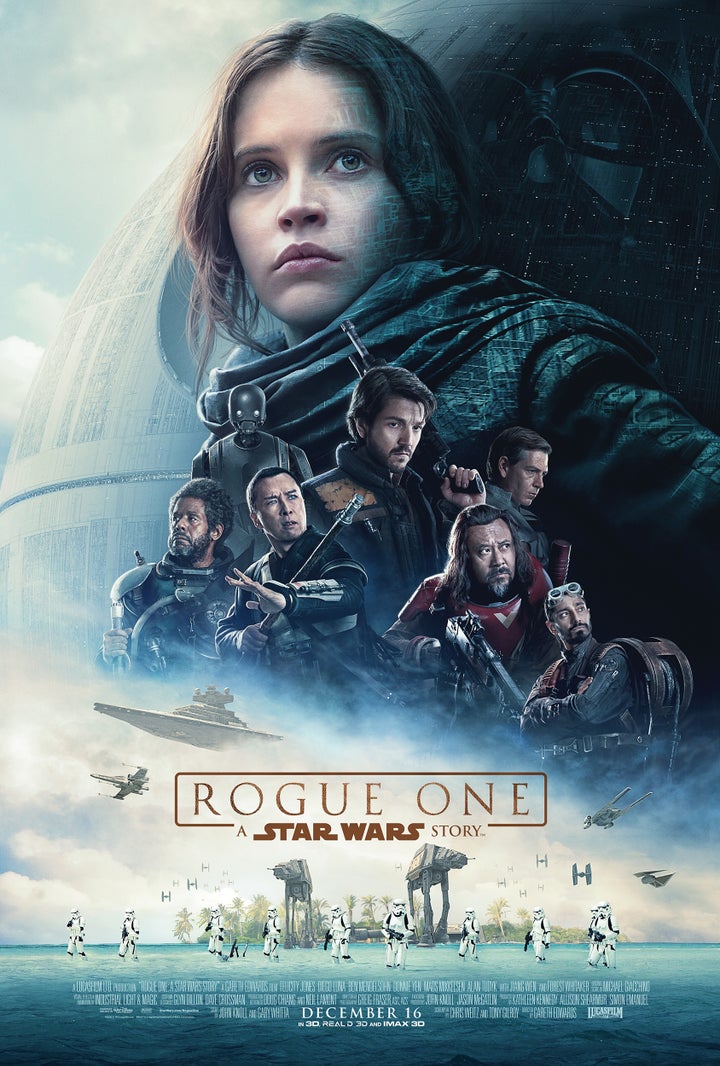
This review originally appeared at Big Shiny Robot!
This review endeavors to be spoiler-free but read it at your own risk. One person’s context is another person’s spoiler.
In Rogue One: A Star Wars Story, Gareth Edwards and company manage to reinvent Star Wars into something it has never been: it takes the simple black/white morality and introduces gray. The entire film is about gray areas: he gray areas between hope and despair, between good and evil, between right and wrong. It draws from the same cinematic well that inspired George Lucas a delivers a film that puts the “war” back in Star Wars. But perhaps the most important war is not the intergalactic civil one, but the one that rages in our hearts: are we willing to do bad things to accomplish good? This film will captivate and, more importantly, challenge audiences in a way many Star Wars fans will be unaccustomed to. In that way, it delivers something wholly new and unexpected― while set against a familiar backdrop that audiences love. Its complexity lies in this gray area and we’re left to search for meaning among the poles of thought between each of the characters and situations. That makes the movie an engaging exercise in audience participation, forcing us to take a side, just as it does each of the characters.
Yes, as I said it’s a war film, too. More importantly, it’s a Star Wars film. And it had the Herculean task of being the first standalone in the franchise–and that is a heavy burden.
In some ways, the task before Gareth Edwards and his cast and crew was as impossible as the task of stealing the Death Star plans. Would Gareth Edwards and the rest of his team be able to pull off the impossible? The answer is an emphatic yes. They pulled off the impossible and more.
Like any good war film, the mission coalesces quickly. There’s a Death Star. They need to find out more about it. The mission goes further and further south the more complex it gets. At one point in the film, Felicity Jones as Jyn Erso says that they need to keep taking chances until they succeed or their chances are spent, and that’s largely how the whole film plays out. Like any great war film, Rogue One focuses on the characters and makes you care about them desperately. Each character of the group is sharply written and realized and they find ways to surprise you while remaining consistent, from the first scenes they’re in, all they way to their last.
Each actor on the main team finds a way to stand out and work your way into your heart. Diego Luna’s Cassian Andor is complicated and conflicted, but as we learn more about him, can we blame him for the actions he takes? The more we learn about him and the stakes involved, horrible things seem acceptable. Donnie Yen and Jiang Wen, as Chirrut Imwe and Baze Malbus both steal the show in their scenes as a contradiction unto themselves. One is a devout believer in the Force, the other the Star Wars equivalent of an atheist. Together, they create another gray area, reinforcing the themes of the film. More than that, they kick ass and they’re funny. Riz Ahmed’s Bodhi Rook is a defected Imperial Pilot trying to make up for the wrongs he might have contributed to by supporting the Empire, and asks the audience at one point to look past the uniform, another theme through the film. But the real superstar is going to be Alan Tudyk’s reprogrammed Imperial droid, K-2SO. He’s charming, funny, and full of so much heart that it would be impossible not to like him.
For the bad guys, we have, largely, Ben Mendelsohn, who plays a scheming sort of Imperial engineer trying to play the military man with aplomb. He’s stellar in the scenes he’s given. And there are two other Imperial presences in the film that we’ll talk more about in a spoiler-filled review later. Long story short: they worked very well for me.
The supporting cast is equally great, whether that’s Jimmy Smits and Genevieve O’Reilly returning to their roles as Bail Organa and Mon Mothma, or Forest Whitaker as Saw Gerrera. And Mads Mikkelson adds a beating heart to the underlying premise of the film, even though he might have had more screen time in Dr. Strange.
This film asks hard questions and tests each of the characters to the limit. And it’s made with a bold brush of filmmaking that one would expect from George Lucas, and it’s a little surprising that it came from Gareth Edwards. Like the films Lucas made, It gives us something familiar, but new. It looks to the past of film history while pushing the boundaries of what is possible from the art. And it seems so heavily influenced by Lucas, but not from his Star Wars films as much as THX-1138. There’s an aural quality to the audio that feels like THX, and there’s one sequence, in the archive tower, that has visual and technology references to Lucas’s bleak vision of the future.
This is why I will declare that it’s a better film than last year’s The Force Awakens.
Where The Force Awakens clung to the tradition of Star Wars itself and moved you through the story so fast that it was hard to keep track of character motivations, Rogue One was sharply written and edited and references the films behind it in a much better way. This way, it’s able to bring more “new” to the table and show us something we haven’t seen before. Part of that is the conceit of the standalone films themselves. Gareth Edwards was able to shoot in a more documentary-like style, something Lucas obsessed over with American Graffiti, and Edwards was able to make bold camera and lens choices, something Lucas established wasn’t in the visual language of the Skywalker saga.
This is Star Wars unleashed. And it’s beautiful.
There’s an urgency to the film, too. It’s asking us to make the right choice and fast. And that’s not always a clean process. It’s messy. And that’s where the dissection of the film becomes fascinating. But on the other hand, Chirrut reminds us that “All is as the Force wills it.” Everything that had to happen in order to allow A New Hope to happen did. But it is done in such a refreshing way that you’re left torn between despair and hope.
The film is chock full of surprises that I don’t want to ruin here, but fans of Revenge of the Sith, A New Hope, and Star Wars Rebels will have a lot to love if they know where to look.
Fans of politics in Star Wars have a lot to grab onto as well. Going back to the gray areas, what’s the difference between a freedom fighter or a rebel or a terrorist? What does a bad guy look like? Is it their uniform? Is it what they’re willing to do for the right reasons? Every scene set in the holy city of Jedha seemed tailor-made for the political turmoil of today and a hundred years ago and, Force forbid, a hundred years from now. It looks vaguely Middle Eastern, the freedom fighters use guerilla tactics against the Empire in the way we’ve read about terrorists in foreign countries attacking convoys of troops. Who is right? Who is wrong? The film asks us to reevaluate who is a bad guy and who isn’t in a way that easily crosses over into the real world.
Music lovers also have nothing to worry about: Michael Giacchino hit a homerun with his score, creating enough new material and borrowing enough existing material to make it feel fresh and familiar all at the same time. In fact, there were times where I thought the music was John Williams, even if I didn’t recognize it. It helped sell the tone of the film in a way that wasn’t distracting and was great.
Much will be said about the prologue being included rather than a crawl, but I would argue that a crawl for this story would have been all wrong. The prologue gives us a much more personal look at the context and stakes of the story that a crawl would have robbed us of.
As for the rest of the screenplay, it’s fantastic. Its efficiency is remarkable. And the way it streamlines itself toward the end of the film, removing every unnecessary element one at a time until only the most important storyline matters is breathtaking. This was another thing that made it feel more Lucas-like: every time a new objective in the mission was added, there was a clear explanation as to how it would need to work, so that we as an audience could gauge its success or failure as it unfolded on screen. That was missing in The Force Awakens. The space and ground battles here have clear objectives and goals and we understand the geography of them, where in The Force Awakens, they just shrug and say, “Shoot it more.”
And that’s to say that the ground and space battles in this film rival The Empire Strikes Back and Return of the Jedi. There’s not a moment that goes by where you’re not completely invested in all of the different battles of the final act of the film.
And the last five minutes of the film are so desperate and arresting that I wonder if this might be one of the best endings for a Star Wars movie we’ve ever seen. Partially because it literally robs you of breath, partially because the last bit will completely change your perspective of A New Hope forever.
This film is Gareth Edwards masterpiece. He’s made a near-perfect Star Wars war film. He’s never made a better film. Maybe he’ll never make one better than this, either. This film will climb the ranks of favorite Star Wars films among fans, but will it have the repeat viewings that will drive the box office over the top like The Force Awakens? That depends on how much audiences like going back to such a bleak world. I, for one, welcome such a film and I can’t wait to go see it again.
The only thing that makes it not a perfect 10 in my mind were a couple of wonky moments that took me out of the film upon first viewing. They may smooth out upon further viewings and I could totally re-rate it. But I’ve seen it twice now and it seems to get better with each viewing, as Star Wars films should.
This is a stunning 9.5 out of 10. See it now. See it often.
For a more in-depth, spoiler-filled discussion of the film, tune into the Full of Sith podcast on Thursday, 12/16 at 7pm EST for a 2-hour special episode.
